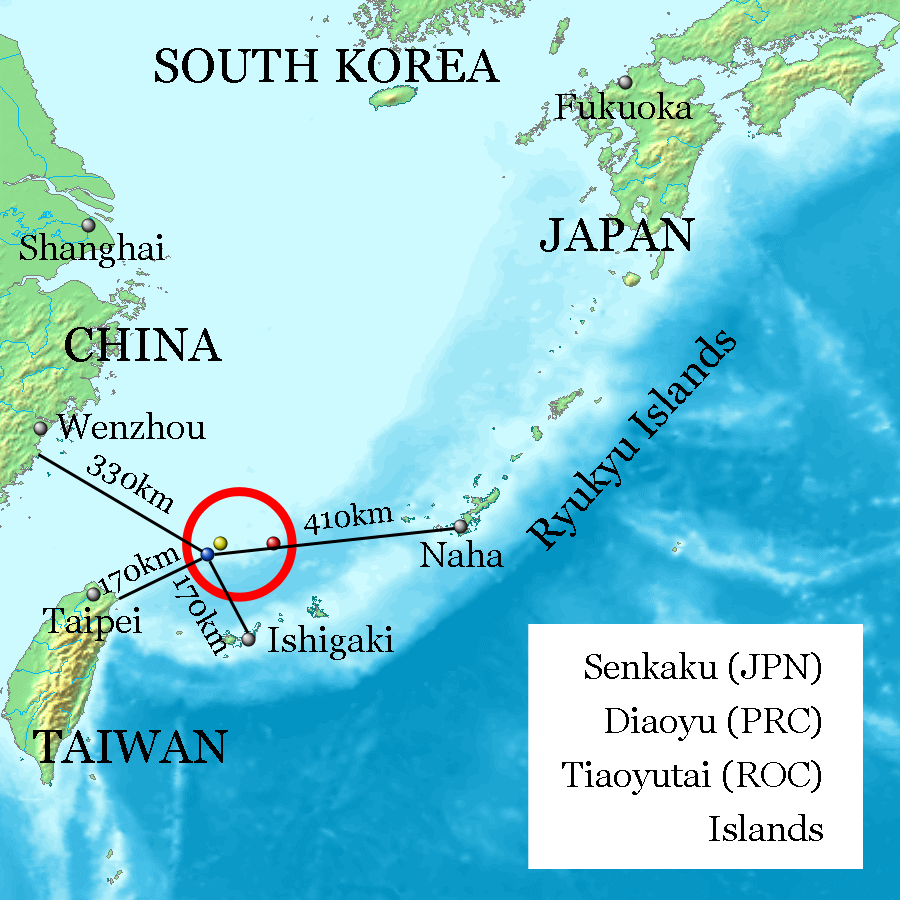International Relations
Senkaku Islands
- 23 Jun 2020
- 6 min read
Why in News
Recently, a local council in southern Japan has approved a bill to change the name of an area containing Senkaku Islands from Tonoshiro to Tonoshiro Senkaku.
- Senkaku Islands are known as the Diaoyus by China and Tiaoyutai by Taiwan.
- The islands are disputed with China and Taiwan.
Key Points
- Japan's Stand:
- Resolving Administrative Confusion: The name change is aimed at resolving administrative confusion between a locale in downtown Ishigaki, which shares the name "Tonoshiro" similar to the island.
- Increased Chinese Presence: It is also done in response to the increased Chinese presence in the waters close to the Senkakus. In a move to protect territorial integrity, Japan has decided to change the name.
- Support of the USA: The United States has a mutual defense treaty with Japan. If Japanese territory is attacked by a foreign power, the United States is obligated to defend it.
- China's Stand:
- China’s Territorial Sovereignty: Bill by Japan is a serious provocation to China’s territorial sovereignty. The move is illegal.
- Four-Principle Consensus: Urged Japan to abide by the spirit of the four-principle consensus, avoid creating new incidents on the Diaoyu Islands issue, and take practical actions to maintain the stability of the East China Sea situation.
- A four-point principle on improving China-Japan ties was approved in 2014 to develop a mutually beneficial relationship based on common strategic interests.
- Risk of a Crisis: Changing the administrative designation would only make the dispute more complicated and bring more risks of a crisis
- Taiwan's Stand:
- It also protested the move and claimed that the islands are part of its territory, and the sovereignty of Tiaoyutai islands belongs to the country and any move attempting to alter this fact is invalid.
- Overall Impact:
- Asia's next military flashpoint:
- Japan is not the only territorial and maritime dispute that China has long had with many of its neighbours.
- It has island and maritime border disputes with Taiwan, Brunei, Indonesia, Malaysia, Philippines and Vietnam in the South China Sea and its extension.
- Hence, Japan's move can strengthen the other countries territorial and maritime claims.
- Asia's next military flashpoint:
- Significance for India:
- The development from Japan came just after the violent clash between Indian and Chinese troops over the Line of Actual Control in Ladakh’s Galwan Valley.
- Given the trade volume and economic dependency that is the most dominant feature of the bilateral relationship, it would be crucial for India to act wisely.
- By supporting the Japanese move, India can diplomatically strengthen its position over Galwan Valley.
- However, Taiwan's engagement in the dispute is significant as it has supported India over the galwan valley but opposes the move of Japan.
- China has also augmented its naval power to strengthen its overall presence in the Indian Ocean. The move of Japan would give an opportunity to India to have a strategic edge over its presence in the Indian Ocean.
The Senkakus Island Chain Dispute
- The Senkaku Islands dispute, or Diaoyu Islands dispute, concerns a territorial dispute over a group of uninhabited islands known as the Senkaku Islands in Japan, the Diaoyu Islands in China and Tiaoyutai Islands in Taiwan.
- Eight uninhabited islands lie in the East China Sea. They have a total area of about 7 sq km and lie northeast of Taiwan.
- Importance: Islands are close to strategically important shipping lanes, offer rich fishing grounds and are thought to contain oil deposits.
- The Senkakus island chain has been administered by Japan since 1972, but its legal status has remained disputed until now.
- Both Japan and China claim ownership of these islands.
- Japan's Claim:
- After World War II, Japan renounced claims to a number of territories and islands including Taiwan in the 1951 Treaty of San Francisco.
- But under the treaty the Nansei Shoto islands came under US trusteeship and were then returned to Japan in 1971.
- Japan says that Senkaku islands are part of the Nansei Shoto islands and hence they also belong to Japan.
- Besides, China raised no objections to the San Francisco deal. Only since the 1970s, when the issue of oil resources in the area emerged, that Chinese and Taiwanese authorities began pressing their claims.
- China's Claim:
- These Islands have been part of its territory since ancient times, serving as important fishing grounds administered by the province of Taiwan.
- When Taiwan was returned in the Treaty of San Francisco, China said the islands – as part of it – should also have been returned.





